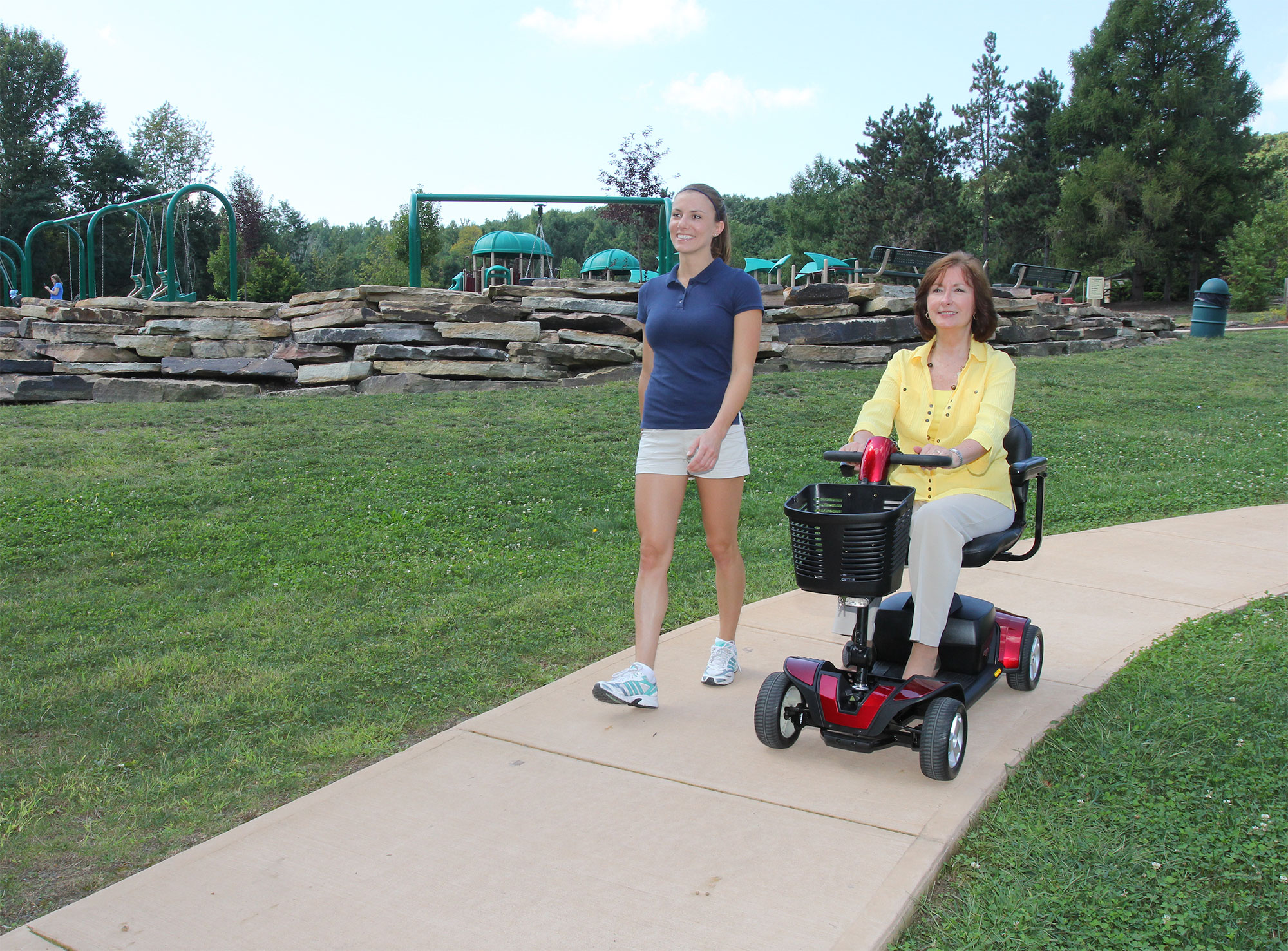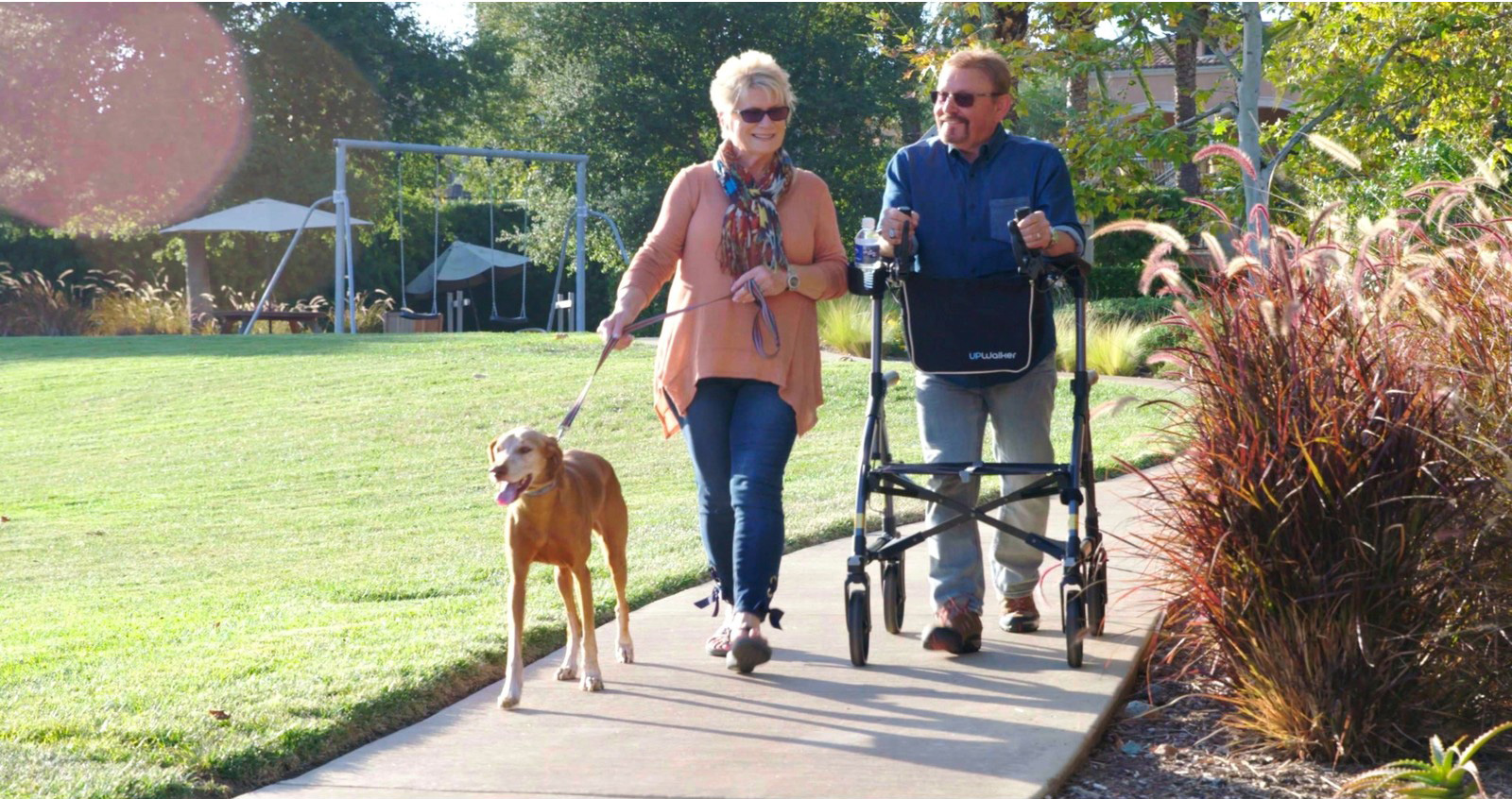Finding Independence Through Mobility Aids: Understand How to Choose the Right Mobility Aid
Maintaining independence is crucial for individuals facing mobility challenges, as it significantly impacts their overall quality of life and well-being. Independence allows individuals to perform daily activities, engage in social interactions, and retain control and dignity. However, mobility limitations can pose significant barriers to achieving these goals, often leading to feelings of frustration, dependency, and isolation.
At AZ MediQuip, we understand that mobility aids are pivotal in enhancing independence for those with mobility challenges. These devices, which include canes, walkers, wheelchairs, and scooters, are designed to provide support, stability, and improved mobility. By utilizing the appropriate mobility aid, individuals can overcome physical limitations, enabling them to navigate their environments safely and confidently.
The right mobility aid can transform lives by promoting greater freedom of movement, reducing the risk of falls, and increasing participation in social and recreational activities. It also contributes to mental and emotional well-being by fostering a sense of autonomy and self-reliance. Whether for short-term recovery or long-term assistance, mobility aids are essential tools that empower individuals to maintain their independence and enjoy a higher quality of life.
Understanding Mobility Aids
Mobility aids are devices designed to help individuals with physical limitations move more freely and safely. They come in various forms, each tailored to specific needs and conditions. Canes provide simple support for balance and stability, often used by individuals with minor mobility issues. Walkers offer more substantial assistance, featuring a frame surrounding the user, giving extra support and reducing the risk of falls.
Wheelchairs, both manual and electric, are essential for those with severe mobility impairments. They provide a means to move independently without relying on leg strength. For example, the Journey Health & Lifestyle Journey Air Elite offers Maneuver effortlessly with the user-friendly joystick and powerful dual drive system. Scooters, similar to electric wheelchairs, are beneficial for longer distances and outdoor use, offering a convenient and comfortable way to navigate larger areas.
The benefits of using mobility aids are vast. They significantly enhance the quality of life for individuals with mobility challenges by enabling them to perform daily activities with greater ease and confidence. Mobility aids reduce the risk of falls and injuries, thereby promoting safety. They also alleviate physical strain, allowing users to conserve energy and reduce pain associated with movement. Additionally, these aids foster social inclusion by making it easier for individuals to participate in social, recreational, and occupational activities, ultimately leading to improved mental and emotional well-being.
How Mobility Aids Enhance Independence
Mobility aids significantly enhance independence by enabling individuals with mobility challenges to perform daily activities and effectively maintain social connections. These assistive tools provide the necessary support to accomplish tasks that might otherwise be difficult or impossible, such as walking to the store, navigating the home, or engaging in recreational activities. With the right mobility aid, individuals can regain control over their routines, leading to a more fulfilling and active lifestyle.
One of the primary benefits is the increased confidence and safety they offer. By providing stability and support, devices such as canes, walkers, wheelchairs, and scooters reduce the risk of falls and injuries. This assurance allows users to move around with greater freedom and less fear of accidents. As a result, individuals are more likely to venture out and engage with their communities, thereby maintaining and strengthening social connections. This social engagement is crucial for mental and emotional well-being, as it helps combat feelings of isolation and depression.
Another crucial aspect of mobility aids is their role in promoting physical health and wellness. Regular movement and physical activity are essential for maintaining muscle strength, joint flexibility, and cardiovascular health. These aids enable users to stay active, which can help manage chronic conditions such as arthritis, diabetes, and cardiovascular disease. For instance, using a walker or cane can encourage more frequent walking, supporting overall physical fitness and health. Additionally, they can prevent the secondary complications of immobility, such as pressure sores, muscle atrophy, and poor circulation.
Tips for Choosing the Right Mobility Aid
Choosing the right mobility aid is a critical decision that can significantly impact your independence, safety, and overall quality of life. AZ Mediquip has various options available for you to select an aid that is specific to your needs and lifestyle. Here are some detailed tips to guide you through the process:
Assess Your Needs
Before selecting a mobility aid, you must thoroughly assess your mobility challenges and lifestyle requirements. Consider the following factors:
- Stability: Evaluate how much support you need. If you have minor balance issues, a cane might suffice. However, a walker or rollator might be better if you require more stability.
- Strength: Consider your upper body strength, as some aids, like manual wheelchairs, require significant arm power.
- Endurance: Reflect on how long you can walk or stand without discomfort. For longer distances, you might need a scooter or an electric wheelchair.
Understanding your unique needs can help you narrow down the options and choose a mobility aid that offers the right level of support.
Consult with Healthcare Professionals
Seeking advice from healthcare professionals, such as doctors, physical therapists, or occupational therapists, is crucial in selecting the most suitable mobility aid. These professionals can provide valuable insights based on their expertise and experience.
- Professional Assessments: A thorough evaluation by a healthcare professional is essential in identifying specific mobility issues and recommending the most suitable aids. During this assessment, a doctor, physical therapist, or occupational therapist will comprehensively review your medical history, physical capabilities, and current challenges. This process may include physical examinations, strength and balance tests, as well as discussions about your daily routines and mobility goals. The insights gained from this evaluation allow the healthcare professional to pinpoint the exact areas where assistance is needed.
- Customized Recommendations: Healthcare professionals can offer customized recommendations tailored to your individual needs, considering various factors like your medical condition, physical capabilities, and daily activities. For instance, if you have arthritis, they suggest a cane with an ergonomic handle to reduce hand strain. For those with severe mobility impairments, mobility aids also contribute to better physical health. By enabling regular movement and exercise, they help maintain muscle strength, joint flexibility, and cardiovascular health. For instance, using a walker can encourage more frequent walking, which benefits overall fitness. Moreover, these aids enhance mental and emotional well-being. The ability to move independently and participate in social activities combats feelings of isolation and depression, promoting a more active and engaged lifestyle. If you live in a multi-story home, a stairlift might be a necessary addition. A walker with large, sturdy wheels might be more appropriate if you frequently travel outdoors. The customization process involves assessing your lifestyle and the environments where you will use the mobility aid.
Try Before You Buy
Testing different mobility aids before purchasing is essential to ensure you find the best fit. Here are some tips on what to look for during trials:
- Comfort: Ensure the device feels comfortable to use. Pay attention to the handles, seat, and overall design.
- Ease of Use: Test how easy it is to operate the aid. For example, check if you can fold and unfold a walker or adjust the height of a cane without difficulty.
- Maneuverability: Assess how well you can navigate with the device. Try turning corners, moving on different surfaces, and using the aid in various settings.
You can find a mobility aid that meets your comfort and usability needs by trying out different options.
Consider the Environment
The environment where you will primarily use the mobility aid plays a significant role in your decision. Evaluate the following aspects:
- Home: When selecting a mobility aid for indoor use, it’s essential to ensure that it fits through standard doorways and can easily navigate tight spaces, such as hallways and around furniture. Consider the width and maneuverability of the aid; for example, a narrow walker or a compact wheelchair may be more suitable for moving around in a home environment. Additionally, think about the flooring in your home. Devices with rubber tips or wheels that can glide smoothly over carpets, tiles, and hardwood floors can make indoor navigation more comfortable and efficient. It’s also helpful to consider aids that can easily transition from one room to another, allowing for seamless movement throughout the house.
- Outdoors: For outdoor use, mobility aids need to be robust and durable to handle various terrains and weather conditions. Look for aids with larger, more rugged wheels that can manage uneven surfaces, such as gravel, grass, or cobblestones. Sturdy construction is crucial to withstand the wear and tear of outdoor use. Features like shock absorbers can also enhance comfort when moving over bumpy surfaces. Additionally, consider aids with built-in brakes or stabilizers to ensure safety on inclines or slippery surfaces. These features can provide the necessary stability and support for confidently navigating parks, sidewalks, and other outdoor environments.
- Public Spaces: When using a mobility aid in public spaces, portability and ease of transportation become critical factors. If you frequently travel or need to transport your mobility aid in a car, look for lightweight and foldable options that are easy to carry and store. Compact designs that can be quickly disassembled or folded are particularly beneficial for navigating crowded areas or using public transportation. Additionally, aids with adjustable height settings can accommodate different seating arrangements in public spaces, ensuring comfort and accessibility. For added convenience, consider mobility aids with built-in storage options, such as baskets or bags, to carry personal items while on the go.
Selecting a mobility aid versatile enough for various settings ensures you can maintain your independence both at home and in the community.
Factor in Long-Term Use
When choosing a mobility aid, it’s essential to consider its long-term use. Here are some factors to keep in mind:
- Durability: Look for devices made from high-quality materials that can withstand regular use.
- Maintenance: Consider how easy it is to maintain and clean the aid. Some devices may require regular servicing to ensure optimal performance.
- Repair and Replacement: Check the availability of replacement parts and repair services. Choosing a reputable brand with good customer support can save you time and hassle in the long run.
By factoring in these elements, you can select a mobility aid that remains reliable and functional over time.
Additional Features to Consider
When choosing a mobility aid, additional features can enhance comfort, usability, and convenience. Consider the following:
- Ergonomic Design: When selecting a mobility aid, it is essential to prioritize comfort to ensure its prolonged and effective use. Look for aids with ergonomic designs that feature well-padded handles, seats, and controls. Ergonomic handles, for instance, are shaped to fit the natural contours of the hand, reducing strain and fatigue during use. Well-cushioned seats provide comfort during extended periods of sitting, which is crucial for wheelchair users. Controls, such as brakes and adjustments, should be easily accessible and require minimal effort to operate. These ergonomic features enhance the user experience by reducing discomfort and promoting proper posture, making it easier to rely on mobility aids for everyday activities.
- Lightweight and Foldable: For those who need to transport their mobility aid frequently, choosing a lightweight and foldable option can greatly enhance convenience. Lightweight aids are easier to lift and maneuver, reducing the physical strain on the user or caregiver. Foldable designs are particularly beneficial for travel, as they can be easily stored in the trunk of a car or taken on public transportation. These aids can be quickly folded and unfolded, making them ideal for spontaneous trips or daily commutes. By opting for a lightweight and foldable mobility aid, users can maintain their independence and mobility without being restricted by cumbersome equipment.
- Accessories and Customization: Mobility aids with accessories and customizable features can significantly improve their practicality and user satisfaction. Some aids come with built-in storage baskets or bags, allowing users to carry personal items, groceries, or medical supplies conveniently. Cup holders can be attached to keep beverages within easy reach, while adjustable height options ensure the aid fits the user’s body dimensions perfectly, promoting better posture and comfort. Customization extends to features like wheel size, seat width, and handle height, enabling users to tailor the device to their specific needs and preferences. These additional features not only enhance the functionality of the mobility aid but also provide a more personalized and comfortable experience for the user.
Specific Benefits of Mobility Aids
Mobility aids offer numerous specific benefits that significantly enhance the lives of individuals with mobility challenges. One of the primary advantages is improved independence, allowing users to perform daily tasks such as shopping, cooking, and socializing without relying on others. This autonomy fosters a sense of self-reliance and dignity.
Safety is another crucial benefit. Mobility aids like canes, walkers, and wheelchairs provide stability and reduce the risk of falls and injuries, ensuring users can move around confidently and securely. This safety aspect is crucial for older adults and those with chronic conditions.
Mobility aids also contribute to better physical health. By enabling regular movement and exercise, they help maintain muscle strength, joint flexibility, and cardiovascular health. For instance, using a walker can encourage more frequent walking, which benefits overall fitness. These aids enhance mental and emotional well-being. The ability to move independently and participate in social activities combats feelings of isolation and depression, promoting a more active and engaged lifestyle.
Choosing the Right Mobility Aid with AZ MediQuip
Determining which mobility aid is right for you is essential for maintaining independence and improving your quality of life. At AZ MediQuip, our team consists of highly trained and knowledgeable staff who provide personalized consultations to assess and address your unique healthcare needs. The right mobility aid enhances freedom and safety and boosts confidence and overall well-being.
We invite you to explore AZ MediQuip’s website, where you can shop a wide range of high-quality mobility aids tailored to meet diverse needs. Embrace the enhanced freedom and quality of life that the right mobility aid can provide, empowering you to live a more active and fulfilling life.
Browse our website to shop our wide range of mobility aids and find the perfect solution for your needs.

















